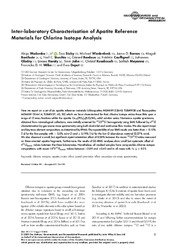Inter‐laboratory Characterisation of Apatite Reference Materials for Chlorine Isotope Analysis
Słaby, Ewa
Wiedenbeck, Michael
Barnes, Jaime D.
Bonifacie, Magali
Sturchio, Neil C.
Bardoux, Gérard
Couffignal, Frédéric
Heraty, Linnea
Kusebauch, Christof
Mayanna, Sathish
Wilke, Franziska D. H.
Deput, Ewa
DOI: https://doi.org/10.1111/ggr.12366
Persistent URL: http://resolver.sub.uni-goettingen.de/purl?gldocs-11858/8441
Persistent URL: http://resolver.sub.uni-goettingen.de/purl?gldocs-11858/8441
Wudarska, Alicja; Słaby, Ewa; Wiedenbeck, Michael; Barnes, Jaime D.; Bonifacie, Magali; Sturchio, Neil C.; Bardoux, Gérard; Couffignal, Frédéric; Glodny, Johannes; Heraty, Linnea; John, Timm; Kusebauch, Christof; Mayanna, Sathish; Wilke, Franziska D. H.; Deput, Ewa, 2020: Inter‐laboratory Characterisation of Apatite Reference Materials for Chlorine Isotope Analysis. In: Geostandards and Geoanalytical Research, DOI: 10.1111/ggr.12366.
 |
Dokument öffnen: |
Here we report on a set of six apatite reference materials (chlorapatites MGMH#133648, TUBAF#38 and fluorapatites MGMH#128441A, TUBAF#37, 40, 50) which we have characterised for their chlorine isotope ratios; these RMs span a range of Cl mass fractions within the apatite Ca10(PO4)6(F,Cl,OH)2 solid solution series. Numerous apatite specimens, obtained from mineralogical collections, were initially screened for 37Cl/35Cl homogeneity using SIMS followed by δ37Cl characterisation by gas source mass spectrometry using both dual‐inlet and continuous‐flow modes. We also report major and key trace element compositions as determined by EPMA. The repeatability of our SIMS results was better than ± 0.10% (1s) for the five samples with > 0.5% m/m Cl and ± 0.19% (1s) for the low Cl abundance material (0.27% m/m). We also observed a small, but significant crystal orientation effect of 0.38% between the mean 37Cl/35Cl ratios measured on three oriented apatite fragments. Furthermore, the results of GS‐IRMS analyses show small but systematic offset of δ37ClSMOC values between the three laboratories. Nonetheless, all studied samples have comparable chlorine isotope compositions, with mean 103δ37ClSMOC values between +0.09 and +0.42 and in all cases with 1s ≤ ± 0.25. Key Points:
Six apatite reference materials having various Cl mass fractions were characterised for chlorine isotope ratios by SIMS and three GS‐IRMS laboratories.
A small, but significant, crystal orientation effect was recorded by SIMS analyses.
Correlation of instrumental mass fractionation factor with Cl mass fraction is visible along the apatite solid solution series.
Statistik:
ZugriffsstatistikSammlung:
Schlagworte:
chlorine isotopesapatite
matrix effect
crystal orientation effect
secondary ion mass spectrometry
This is an open access article under the terms of the Creative Commons Attribution License, which permits use, distribution and reproduction in any medium, provided the original work is properly cited.

